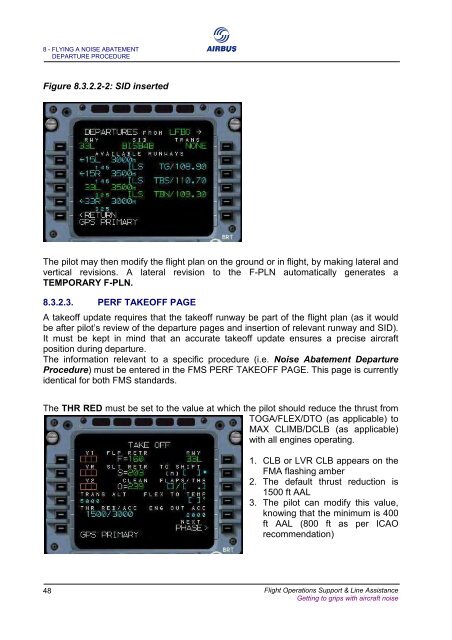Getting to Grips with Aircraft Noise
Getting to Grips with Aircraft Noise
Getting to Grips with Aircraft Noise
You also want an ePaper? Increase the reach of your titles
YUMPU automatically turns print PDFs into web optimized ePapers that Google loves.
8 - FLYING A NOISE ABATEMENT<br />
DEPARTURE PROCEDURE<br />
Figure 8.3.2.2-2: SID inserted<br />
The pilot may then modify the flight plan on the ground or in flight, by making lateral and<br />
vertical revisions. A lateral revision <strong>to</strong> the F-PLN au<strong>to</strong>matically generates a<br />
TEMPORARY F-PLN.<br />
8.3.2.3. PERF TAKEOFF PAGE<br />
A takeoff update requires that the takeoff runway be part of the flight plan (as it would<br />
be after pilot’s review of the departure pages and insertion of relevant runway and SID).<br />
It must be kept in mind that an accurate takeoff update ensures a precise aircraft<br />
position during departure.<br />
The information relevant <strong>to</strong> a specific procedure (i.e. <strong>Noise</strong> Abatement Departure<br />
Procedure) must be entered in the FMS PERF TAKEOFF PAGE. This page is currently<br />
identical for both FMS standards.<br />
The THR RED must be set <strong>to</strong> the value at which the pilot should reduce the thrust from<br />
TOGA/FLEX/DTO (as applicable) <strong>to</strong><br />
MAX CLIMB/DCLB (as applicable)<br />
<strong>with</strong> all engines operating.<br />
48<br />
1. CLB or LVR CLB appears on the<br />
FMA flashing amber<br />
2. The default thrust reduction is<br />
1500 ft AAL<br />
3. The pilot can modify this value,<br />
knowing that the minimum is 400<br />
ft AAL (800 ft as per ICAO<br />
recommendation)<br />
Flight Operations Support & Line Assistance<br />
<strong>Getting</strong> <strong>to</strong> grips <strong>with</strong> aircraft noise


